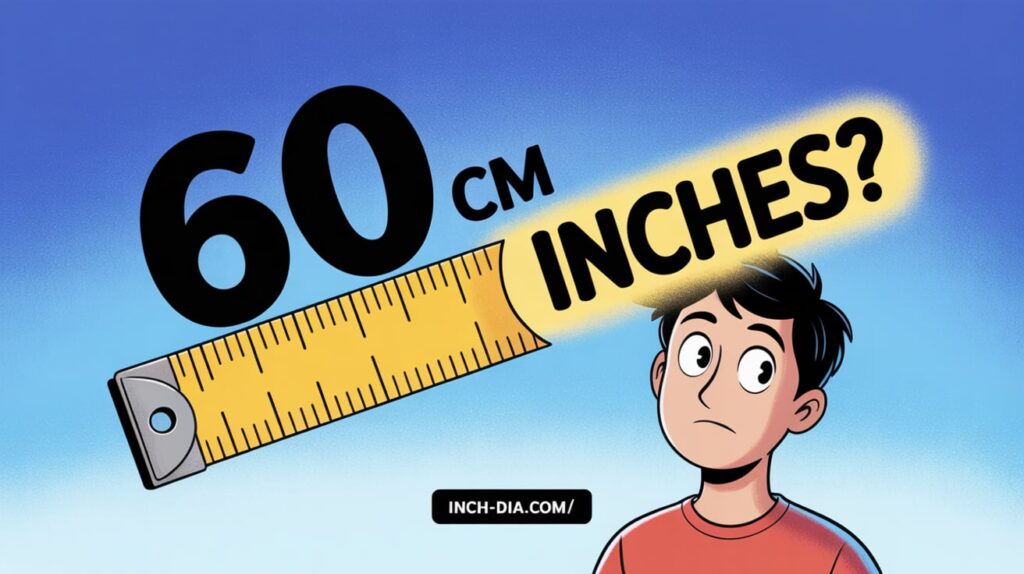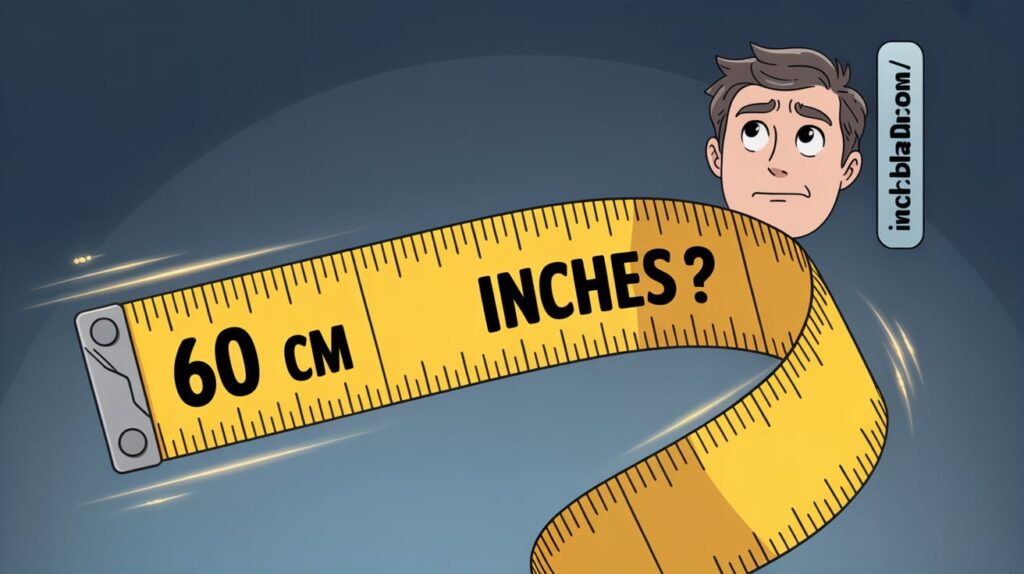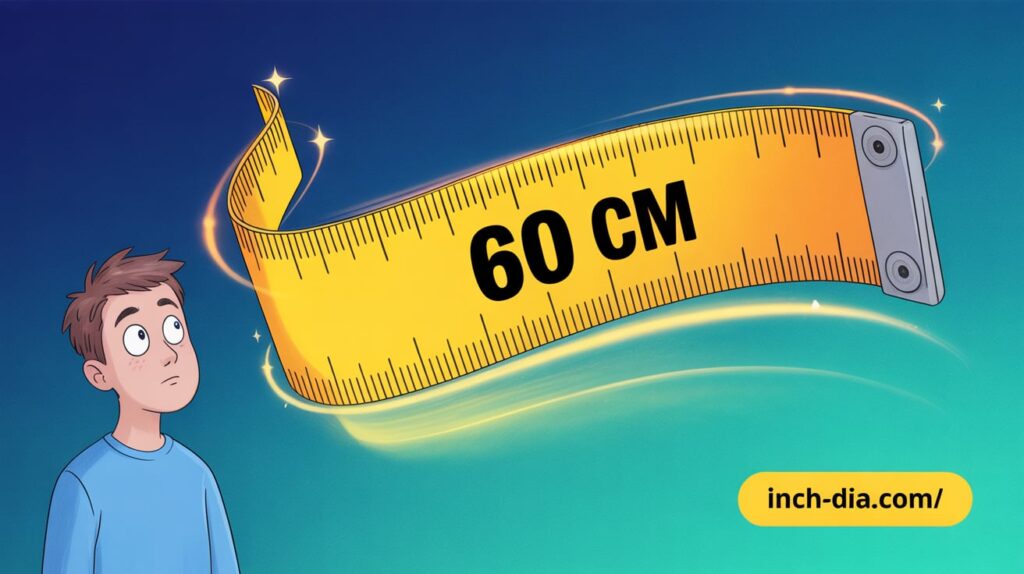Ever found yourself staring at a measurement like 60cm and wondering, “How do I convert 60cm to inches?” Maybe you’re sewing a dress, building a bookshelf, or helping your kid with a math project.
Whatever the reason, 60cm to inches conversion is a skill that comes in handy more often than you’d think.
This quick guide to convert 60cm to Inches will walk you through every step, from the cm to inches formula to real-world applications like 60cm to inches for sewing measurements. By the end, you’ll be a pro at how to convert centimeters to inches, no matter the context.
This guide is packed with practical measurement tips, detailed explanations, and answers to common questions.
Whether you’re a student, a DIY enthusiast, or just curious, you’ll learn how to convert 60 centimeters to inches step by step and understand why metric to imperial conversion matters. Let’s dive in!
What Are Centimeters and Inches?
Before we get to transform 60cm to inches, let’s break down the basics of these two units. Knowing what they are and how they differ sets the stage for accurate conversions.
Defining a Centimeter
A centimeter (cm) is a unit of length in the metric system, which is used in most countries around the world.
One centimeter is one-hundredth of a meter, making it a small but precise unit for measuring things like the width of a book or the height of a plant.
The metric system’s beauty lies in its simplicity everything is based on powers of ten, so scaling up or down is intuitive.
Understanding an Inch
An inch, on the other hand, is part of the imperial system, primarily used in places like the United States and, to a lesser extent, the United Kingdom.
One inch equals exactly 2.54 centimeters, which means it’s a bit longer than a centimeter. Inches are common in everyday scenarios like measuring TV screens, furniture, or even your waist size for a new pair of jeans.

Why These Units Matter
Why do we need to change centimeters to inches? It’s all about context. If you’re in a country that uses the metric system but working with a U.S.-based blueprint, you’ll need to convert metric to inches.
Similarly, if you’re shopping online from a site that lists dimensions in inches but you’re used to centimeters, converting metric units becomes essential. Understanding both units helps you navigate these situations with ease.
Why You Need to Convert 60cm to Inches
So, why specifically focus on 60 centimeters in inches? This measurement pops up in countless scenarios, and knowing how to convert 60cm to inches can save you time and prevent costly mistakes.
Everyday Scenarios for 60cm to Inches Conversion
Here are some situations where you might need to 60cm into inches:
- Sewing and Crafting: If you’re following a sewing pattern from the U.S., it might list measurements in inches, but your fabric is sold in centimeters. Knowing 60cm to inches for sewing measurements ensures your project turns out perfectly.
- DIY Home Projects: Building a shelf? Many U.S. hardware stores list lumber dimensions in inches, so what is 60cm in inches for DIY projects becomes critical.
- Education: Students often encounter unit conversions in math or science classes. Converting 60cm to inches might be part of a homework problem.
- Travel and Shopping: If you’re buying furniture or decor from an international retailer, you’ll need to how to measure 60cm in inches to ensure it fits your space.
The Role of Metric to Imperial Conversion
The world is a mix of metric and imperial systems, which is why metric to imperial conversion is so common.
The metric system is standard in countries like Canada, Australia, and most of Europe, while the imperial system dominates in the U.S.
When these systems collide—say, in international trade or collaborative projects—converting metric units like 60cm equals how many inches becomes a must.
Challenges of Mixed Measurement Systems
Mixing centimeters and inches can lead to confusion. For example, if you assume 60cm is “close enough” to 60 inches (it’s not—60 inches is 152.4cm!).
You could end up with a piece of furniture that doesn’t fit or a garment that’s way too big. That’s why mastering the easy cm to inches conversion is crucial for accuracy.
The Cm to Inches Formula Explained
Now, let’s get to the heart of how to convert 60 centimeters to inches step by step. The cm to inches formula is simple, and once you understand it, you can apply it to any centimeter value.
How to Transform 60cm to Inches
The formula to convert 60cm to inches is:
- Inches = Centimeters × 0.393701
This factor comes from the fact that 1 centimeter equals 0.393701 inches (or, equivalently, 1 inch = 2.54cm, so 1cm = 1 ÷ 2.54 ≈ 0.393701).
Step-by-Step: 60cm Equals How Many Inches
Let’s apply the formula to 60cm to inches conversion:
- Take the centimeter value: 60cm.
- Multiply by the conversion factor: 60 × 0.393701 = 23.62206 inches.
- Round for practical use: 23.62 inches (two decimal places is usually enough for most tasks).
So, 60cm equals how many inches? It’s 23.62 inches.

Verifying Your Calculation
To double-check, you can use the inverse formula (centimeters = inches × 2.54):
- 23.62 × 2.54 = 59.9948cm, which is very close to 60cm, confirming our calculation is spot-on.
For quick estimates, some people use a rough factor of 0.4 (so 60 × 0.4 = 24 inches), but this sacrifices precision. Stick to 0.393701 for accuracy in tasks like 60cm to inches for sewing measurements.
Other Ways to Change Centimeters to Inches
Not a fan of math? No problem! There are alternative methods to convert 60cm to inches that don’t require a calculator.
Using a Centimeter to Inch Converter
Online tools and mobile apps make easy cm to inches conversion a breeze. Just type “60cm” into a centimeter to inch converter, and it’ll spit out 23.62 inches.
Websites like Google’s unit converter or dedicated apps like Unit Converter are great for this. The downside? You need an internet connection, and some tools might return differently, so always verify the result.
Conversion Charts for 60 Centimeters in Inches
A conversion chart is another handy tool. Here’s a snippet of a cm-to-inches chart:
- 50cm = 19.69 inches
- 60cm = 23.62 inches
- 70cm = 27.56 inches
Print out a chart or save one on your phone for quick reference. This is especially useful for what 60 cm is in inches for DIY projects when you’re in the middle of a task and don’t want to stop for calculations.
Pros and Cons of Alternative Methods
- Pros: Converters and charts are fast and require no math skills.
- Cons: You might not have access to tools in every situation, and some converters may not be precise. Always cross-check with the cm to inches formula if accuracy matters.
Real-Life Uses of 60cm into Inches
Knowing 60cm into inches is more than just a math exercise it has practical applications in everyday life. Let’s explore some scenarios where this conversion shines.
What is 60cm in Inches for DIY Projects
Imagine you’re building a custom desk, and the design calls for a depth of 60cm. In the U.S., your local hardware store lists plywood in inches.
By converting 60cm to inches, you know you need a 23.62-inch-deep piece. This ensures your desk fits perfectly in your space, whether it’s a cozy home office or a spacious workshop.
60cm to Inches for Sewing Measurements
Sewing is a prime example of where 60cm to inches for sewing measurements matters. Say you’re making a table runner, and the pattern suggests a 24-inch width, but your fabric is measured in centimeters.
Converting 60cm to inches (23.62 inches) shows it’s just shy of the target, so you might need to adjust your cutting plan. Precision here prevents wasted fabric and ensures a polished final product.
Other Practical Examples
- Home Decor: A 60 cm-wide picture frame is 23.62 inches, helping you decide if it fits above your couch.
- Fitness: Some yoga mats are 60cm wide, and knowing this in inches helps you compare with U.S.-made mats.
- Education: A science project might require a 60cm-long model, and converting to inches ensures it meets competition guidelines in an imperial-based region.
These examples show why a 60cm conversion tutorial is so valuable—it bridges the gap between metric and imperial in real-world tasks.
Measurement Conversion Guide: Tips and Tricks
To make converting metric units like 60cm to inches second nature, follow these practical measurement tips.
Practical Measurement Tips for Accuracy
- Use a Calculator: Even simple multiplications can go wrong if you’re distracted. A basic calculator ensures you nail the cm to inches formula.
- Round Wisely: For most tasks, rounding to two decimal places (23.62 inches) is enough. For ultra-precise work, like engineering, keep more decimals.
- Label Units: When jotting down measurements, write “cm” or “in” to avoid mixing them up.
Avoiding Errors in Converting Metric Units
Common mistakes include:
- Using the Wrong Factor: Mixing up 0.393701 with 2.54 (the latter is for inches to cm).
- Forgetting to Multiply: Some folks assume 60cm is “about” 60 inches, which is way off.
- Misreading Tools: If you’re using a centimeter to inch converter, ensure you input the correct value (e.g., 60, not 6).
To avoid these, double-check your work or use multiple methods (formula and converter) to confirm.
Tools to Simplify Metric System Conversion
- Dual-Scale Rulers: These show both cm and inches, letting you visually compare 60cm to inches.
- Measurement Apps: Apps like Measure or Google’s AR tools can convert units on the fly.
- Conversion Charts: Keep a printed chart in your workshop or sewing kit for quick lookups.
Deep Dive: History of Measurement Systems
To appreciate why we convert metric to inches, let’s take a brief look at the history of these systems.
The Metric System’s Rise
The metric system was born in France during the late 18th century, designed to standardize measurements globally.
Its base-10 structure made it easy to use, and by the 20th century, most countries adopted it. Centimeters became a go-to unit for everyday measurements due to their manageable size.
The Imperial System’s Legacy
The imperial system, with units like inches, has roots in ancient measurements (e.g., the inch was once based on the width of a man’s thumb).
It’s still used in the U.S. because of tradition and the cost of switching to metric. This is why metric to imperial conversion remains relevant.
Why We Still Convert Metric to Inches
Globalization means we’re constantly mixing systems think international shipping, manufacturing, or even online shopping. Knowing how to convert centimeters to inches ensures you can work seamlessly across borders.

FAQs About How to Measure 60cm in Inches
Got questions? Here are answers to common queries about the 60cm to inches conversion.
Is the 60cm Conversion Tutorial Accurate?
Yes, as long as you use the correct cm to inches formula (60 × 0.393701 = 23.62 inches), your conversion is accurate. Online centimeter to inch converters are also reliable if sourced from reputable sites.
Can I Use a Ruler for Easy Cm to Inches Conversion?
A dual-scale ruler can help you visualize 60cm into inches, but it won’t calculate the exact value. Measure 60cm, then check the inch side for an approximate reading (around 23.62 inches).
Why Do Units Differ Globally?
Historical and cultural factors explain the divide. The metric system’s simplicity won over most countries, but the U.S. stuck with imperial due to entrenched practices. This is why metric system conversion skills are essential.
Conclusion
Mastering how to convert 60cm to inches opens up a world of possibilities, from crafting perfect garments to building custom furniture.
With the cm to inches formula (60 × 0.393701 = 23.62 inches), alternative tools like centimeter to inch converters, and our measurement conversion guide, you’re equipped to handle any conversion task.
Whether you’re tackling what is 60cm in inches for DIY projects or 60cm to inches for sewing measurements, this 60cm conversion tutorial has you covered.
Keep practicing, use our practical measurement tips, and soon converting metric units will feel like second nature.
Next time you encounter a 60cm measurement, you’ll know exactly how to transform 60cm to inches with confidence.

